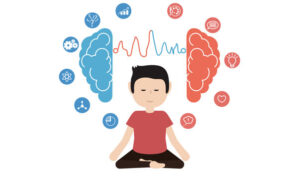Mindfulness Meditation

Close your eyes. Now focus on your breathing. Focus on the steadiness of breathing in and out, in and out. Let this be the anchor for your attention. In this exercise, become aware of your current thoughts.
Let your thoughts come in and be aware of them in the present moment. Do not judge your thoughts, do not attach negative feelings towards your thoughts, accept these thoughts.
Become aware of the distracting thoughts and accept them. Then focus back to your anchor point.
What is Mindfulness?
Mindfulness as a practice was taken from buddhist tradition and has been increasingly used in western society from the 1970s’. The goal of mindfulness based meditations is to reduce stress, anxiety, depression and improve self regulatory skills. For people with ADHD who want to try out non-pharmacological methods for their symptoms, mindfulness is a great way to start.

As you can tell from the example above, mindfulness involves removing distractions and focusing on the present. The goal is to pay attention to the present moment and your current thoughts but with a non judgmental attitude. During this intervention, people focus on their breathing, increase their awareness and remain present in the current experience.
Mindfulness for ADHD
ADHD, a behavioral disorder, can impact interpersonal relationships, academic performance and work related tasks. Mindfulness mediation can improve self regulatory skills which can help people with ADHD decrease their arousal and focus their attention. People with ADHD can feel overwhelmed easily and experience rapid thoughts. Mindfulness for ADHD works to reduce these symptoms and increase control over attention.
Mindfulness techniques you can try on your own:
https://www.pocketmindfulness.com/6-mindfulness-exercises-you-can-try-today/
Mindfulness for ADHD in adults
In one study using mindfulness mediation training with adults with ADHD, about 78% of them had an improvement in their symptoms. Mindfulness practices with adults focus on moment to moment experiences, visual imagery, and expressing loving and kindness towards ones’ thoughts. Rather than became angry at oneself for their ADHD symptoms, mindfulness focuses on accepting these behaviors.
Mindfulness works to let a person recognize when they become distracted and to not just react automatically. After consistently training your brain, a person can be able to stop when they are distracted and refocus their attention. Also, impulsive actions are a strong effect of ADHD, and mindfulness helps reduce these automatic reactions and impulses.
Mindfulness can be an incredibly effective tool for adults as it costs no money, has no side effects and targets the core aspects of ADHD: impulsivity and inattention. Mindfulness for ADHD focuses on helping people become less impulsive and manage their stress better.
Mindfulness for ADHD in children
 Mindfulness techniques can also be used for children. About 5% of children and adolescents are diagnosed with ADHD and many are put on medications. Children with ADHD can be easily distracted, get bored quickly and have difficulty redirecting their attention.
Mindfulness techniques can also be used for children. About 5% of children and adolescents are diagnosed with ADHD and many are put on medications. Children with ADHD can be easily distracted, get bored quickly and have difficulty redirecting their attention.
Mindfulness can help them be aware of when they are distracted and help them focus their attention on the present task at hand. Mindfulness practices for children tend to be shorter, more interactive and use props like teddy bears or other toys. One example of a mindfulness practice for a child is to pick a super hero like spiderman and focus on keeping a spider man pose and using “spidey senses” to be aware of surroundings.
Examples of mindfulness techniques for children: https://positivepsychologyprogram.com/mindfulness-for-children-kids-activities/
Work Cited
Househam, A. M., & Solanto, M. V. (2016). Mindfulness as an Intervention for ADHD. The ADHD Report, 24(2), 1-9.
de Bruin, E. I., & Bögels, S. M. (2016). Mindfulness training for childhood ADHD.
https://mindfullyadd.com/adhd-mindfulness-craze/
https://www.psychologytoday.com/blog/here-there-and-everywhere/201206/adhd-mindfulness-interview-lidia-zylowska-md
